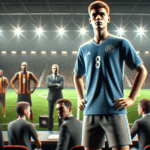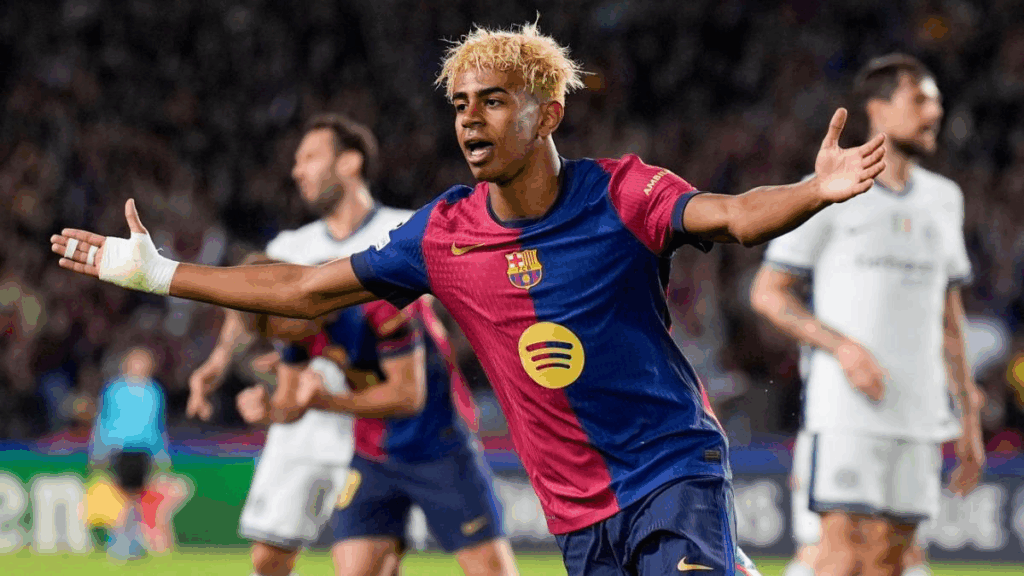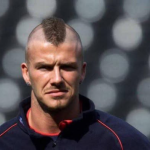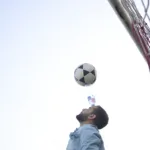Why Elite Footballers Are Now Training in the Dark

I stand in the darkened silence of a rectangular chamber, 8 meters long and 6 meters wide, balanced on the tips of my toes. On the wall in front of me are the outlines of two circles. Beyond these walls is an enormous insulated hangar decked with artificial grass and filled with highly paid professional soccer players. The lower circle glows a brilliant white in the dim light. I brace, as though waiting for the Death Star to ready its superlaser.
One second passes.
Clunk—pause—whoosh!
A soccer ball fires from the illuminated hole, accelerating to 35 miles per hour and shooting through the darkness, before slapping onto my right foot and spinning awkwardly off behind. I turn, and it takes another two touches before I’ve brought the ball fully under my control. A professional player would have managed it in one, and would have done so without making a sound. The next four balls are fired with similarly dismal outcomes. I fear that I am going to be escorted from the facility on the grounds of supreme incompetence.
In an era where marginal gains determine victory or defeat, professional football clubs are turning to cutting-edge neuroscience to gain a competitive edge. One of the most intriguing innovations reshaping player development in 2025 is Okkulo football training — a UK-based company using light-deprived environments to train visual-motor perception in elite athletes. What sounds like science fiction is now being practiced at top-tier clubs like Sunderland AFC, Leeds United, and even considered by global giants across sports.
But why are footballers stepping into dark rooms to improve their game—and does it actually work?
What Is Okkulo Training?
Okkulo has developed a specialized training chamber where players perform drills under dimmed, color-filtered lighting conditions—red, green, blue, or combinations thereof. The goal? To manipulate the speed at which visual information is processed by the brain. This form of neurosensory conditioning forces the athlete to function in degraded sensory environments, thereby recalibrating the brain to respond more efficiently in normal match lighting.
Under these altered conditions, the neural pathways responsible for visual recognition, depth perception, and motor responses are stretched and trained. When the lights return to standard brightness, athletes report feeling “superhuman”—capable of processing and reacting faster than before.
The Neuroscience Behind the Dark
This training method is rooted in the principles of sensory attenuation and recalibration. Specific wavelengths of light—especially red and blue—are known to disrupt visual processing speeds, causing a deliberate delay in the eye-brain communication loop. Okkulo’s system measures these effects precisely and builds drills to stimulate adaptation.
In essence, athletes learn to process information in “slow motion.” When normal conditions return, their neurological efficiency is enhanced, resulting in quicker reflexes, faster decision-making, and improved spatial awareness. Think of it as resistance training for the brain’s visual cortex.
Data-Backed Performance Gains
In controlled trials, the results have been striking. At Sunderland AFC, after six weeks of Okkulo training:
- Players improved target recognition speed by 60%
- Peripheral visual accuracy increased by 10%, and speed by 20%
- Depth perception accuracy improved by 45%
- Reaction times (sensory + motor) were enhanced by over 30%
These metrics are not just promising—they’re game-changing. While standard training methods address physical performance, Okkulo zeroes in on cognitive and sensory agility, the often-overlooked edge in high-level sport.
Clubs, Coaches, and the Competitive Edge
Okkulo’s light training chambers are already being customized to fit club-specific routines. Coaches at Sunderland and Leeds United have integrated Okkulo protocols into goalkeeper training and cognitive testing sessions. Technical directors report sharper on-pitch decisions, better anticipatory movements, and increased confidence among players after completing sessions in the Okkulo environment.
Moreover, the technology isn’t limited to football. Athletes from MLB, NFL, and elite-level cricket have started trialing the system, especially in roles that require split-second judgment—like batting or goalkeeping.
Future Potential: Beyond Training Rooms
As the sports world leans into neuro-performance, technologies like Okkulo represent a shift toward holistic, brain-first coaching. Applications could soon reach:
- Rehabilitation: aiding recovery from concussions or visual impairments
- Youth academies: training adaptability from early development stages
- Home-based elite setups: modular units for personalized cognitive training
However, experts also urge caution. While anecdotal results are powerful, large-scale peer-reviewed studies are still needed to validate long-term efficacy and isolate variables such as placebo effects.
Conclusion
As clubs search for performance advantages beyond nutrition and tactics, Okkulo offers a revolutionary approach to sensory enhancement through light manipulation. It’s not just about seeing better—it’s about seeing smarter and faster. In elite football, milliseconds make legends. With Okkulo, those milliseconds may now be trainable.








